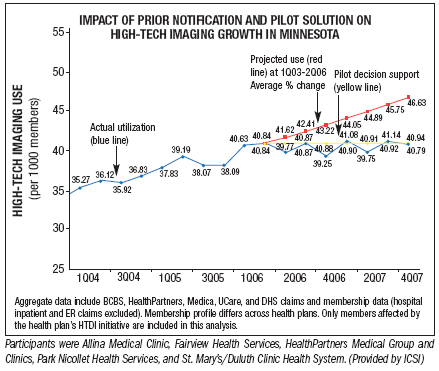Physicians appreciate valueof decision-support system
Physicians and insurers have joined forces in Minnesota to create an entry decision-support system that promises to improve the quality of physician referrals for high-tech medical imaging while linking the process to webbased electronic medical records.
Physicians and insurers have joined forces in Minnesota to create an entry decision-support system that promises to improve the quality of physician referrals for high-tech medical imaging while linking the process to webbased electronic medical records.
The Institute for Clinical Systems Improvement, a nonprofit organization with a history of resolving conflicts between Minnesota’s physicians and insurers, was called in when the two groups clashed in late 2006 over the impending imposition of mandatory prior notification for high-tech imaging.
To foster cooperation, ICSI identified decision support as a potential alternative. First developed and applied by radiologists at Massachusetts General Hospital, orderentry decision support advises referring physicians about the consensus clinical appropriateness of imaging procedures planned for their patients. Operated on a laptop computer, it enables the referring physician to modify an order before its electronic submission.
ICSI developed its own prototype decision-support software and clinical criteria to assess the appropriateness of physician orders for MR, CT, PET/ CT, and nuclear cardiology.
Five large integrated medical groups tested the prototype in a yearlong pilot study. In cooperation with insurers, physicians-including radiologists- worked with ICSI to develop clinical criteria for the decisionsupport software. It expanded upon appropriateness criteria from the American College of Radiology and American College of Cardiology.
The HealthPartners insurance plan and its 600-physician HealthPartners Medical Group helped refine the criteria. Even before the pilot study, the group moved forward to make imaging order-entry decision support broadly available to all its members, said HealthPartners medical director Dr. Patrick Courneya.
“We felt that given good information with the guidance of appropriateness criteria, physicians would tend to make better, more cost-efficient decisions,” he said.
Kevin Palattao, HealthPartners vice president for information technology, developed order-entry software, while Dr. John Butler, physician lead for IT and automation, recruited physicians to assemble clinical criteria that would later be used to strengthen ICSI’s assessment software.
HealthPartners rolled out its order-entry product in February 2007, the same month it introduced mandatory imaging prior notification. Palattao’s engineers also wrote additional software making the system compatible with the EPIC Electronic Patient Record. It was shared with the Minnesota EPIC User Group and made available to the 70% of physician groups that use EPIC in Minnesota.

By verifying through the electronic medical records that their providers were using the expanded ICSI criteria to order scans, the five medical groups participating in the pilot were not required to use prior notification processes established in 2007 by insurers Blue Cross Blue Shield of Minnesota, HealthPartners, and Medica.
From the start, the project emphasized the deployment of educational tools that help ordering physicians make better decisions.
“Our goal was to improve appropriateness,” said Cally Vinz, ICSI’s vice president of clinical products and strategic initiatives. “It was to determine if this alternative to prior notification could be used effectively and efficiently.”
After adjustments to the initial clinical criteria, the pilot program showed that nearly 90% of the orders filed by referring physicians were deemed “high utility” when processed through ICSI’s appropriateness criteria. Only about 1% were judged “low utility.” And 9% were graded as “moderate” utility, Vinz said.
A separate review of 300 patient charts covering three high-tech imaging applications found that 89% of scans ordered by referring physicians who followed recommended appropriateness criteria when they used order-entry decision support were of high utility compared with 79% ordered by physicians who did not use any decision-support.
The order-entry approach combined with prior notification used by the five participating medical groups helped to slow high-tech imaging growth in Minnesota, Vinz said (see graph). Claims for high-tech imaging scans were unchanged in 2007, the year both mechanisms were introduced, after 8% annual growth in 2005 and 2006.
Order-entry decision support proved popular with Minnesota physicians because it is efficient, said Dr. Barry Bershow, medical director for quality and informatics at Fairview Health Services, a pilot program participant in Minneapolis. Compared with prior notification, it generates answers about the appropriateness of procedures in seconds, rather than 30 minutes.
“It fits right in the normal workflow,” he said.
ICSI is following up on the pilot by developing a business plan that would support the rollout of an orderentry decision-support solution across Minnesota. The organization is negotiating with vendors to develop a common set of appropriateness criteria.
ICSI is also seeking to foster compatibility between business software programs, especially the ability to download imaging data from individual physician offices to a central clearinghouse, said Jim Trevis, director of marketing and communications for ISCI.
The data would aid future physician education and potentially help determine how improving the utility of ordered scans contributes to improving patient outcomes, he said.
New MRI Research Explores Links Between Waist-to-Hip Ratio and Memory in Aging
March 13th 2025Researchers found that a higher waist-to-hip ratio in midlife was associated with higher mean diffusivity in 26 percent of total white matter tracts in the cingulum as well as the superior and inferior longitudinal fasciculus.
Can Ultrasound-Based Radiomics Enhance Differentiation of HER2 Breast Cancer?
March 11th 2025Multicenter research revealed that a combined model of clinical factors and ultrasound-based radiomics exhibited greater than a 23 percent higher per patient-level accuracy rate for identifying HER2 breast cancer than a clinical model.